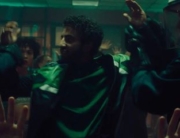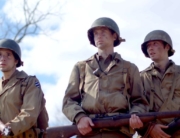Based on R.C. Sheriff’s 1928 play of the same title, Journey’s End follows doomed British infantry stationed in the trenches in northern France during World War I. The film is strongly acted and filmed, with an expert quietness and tense, tight framing.
Its strongest aspect is the muted and desaturated color palette. The actors are constantly stained by muck and grime, accentuated with an overwhelming beige and brown backdrop. The lack of warm colors emphasizes the hopelessness and coldness, and nearly every frame is loaded with a quiet, brooding dread.
Arguably, it’s a safe choice. But one scene definitely stands out. Before the infantry prepares to storm no-man’s-land (the space between the trenches) and capture a German soldier, the camera follows the feet of Lieutenant Osborne (Paul Bettany). The long take weaves through the trenches, while the officer’s boots slosh about in the muck. You can hear him talk up the men he’s taking with him, but something else happens in this shot. The film shows the audience something few films do. Even with the rigid British social hierarchy, particularly embodied in its military structure, war and the threat of death bring the men together as equals. None of the soldiers or officers can escape their fate in the trenches.
The film also doesn’t follow a wartime hero’s tale. There’s no clear through line, and because the film is sourced from a play, the film has an ensemble feel to it. Sam Claflin is deservedly receiving praise for his physical and brooding performance of the alcoholic Captain Stanhope. It would have been easy for it to come off as trite (alcoholic war time officer—name a war movie that doesn’t have one), but in-line with the film’s quiet dread, Claflin underplays the character. It’s clear Stanhope is tortured by the war, but more so, he’s tormented by his duty to comply to orders given from above, particularly by men who are far away from battle.
Strikingly, the film spends a lot of time waiting. This effectively builds tension. We wait with the characters to see if anything is going to happen. Often, the camera emphasizes the vast empty space between the British and German trenches. It’s still and foggy. It really does feel as if something could explode or a shot could ring out at any second.
The final sequence, overall, works very well, where the tension that has been building finally is released when the Germans begin a brutal bombing campaign along the British line. It’s quite sudden. And indeed, until the final moment, in which the camera cuts to an aerial view of the battlefield, you kind of expect certain characters to be alive—but there are no Hollywood tricks or happy endings here.
It’s a bleak but beautifully made, and surprisingly quiet, film.







Leave A Comment